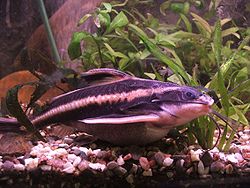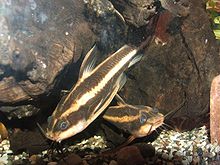- Striped Raphael catfish
-
Striped Raphael catfish 
Scientific classification Kingdom: Animalia Phylum: Chordata Class: Actinopterygii Order: Siluriformes Family: Doradidae Genus: Platydoras Species: P. armatulus Binomial name Platydoras armatulus
(Valenciennes, 1840)Synonyms - Doras armatulus
Valenciennes, 1840
Striped Raphael catfish, Platydoras armatulus, is a catfish of the family Doradidae. It may also be called talking catfish, chocolate doradid, chocolate catfish or thorny catfish.[1] This peaceful, nocturnal species is a popular aquarium fish due to its pleasant temperament and curious nature.[2][3]
The striped raphael catfish has long been identified as Platydoras costatus.[4]
Contents
Origin and distribution
The striped Raphael catfish are commonly found in the Amazon, Tocantins, Parnaíba, Orinoco, Essequibo Rivers in French Guiana and Suriname of South America.[2] They have been introduced into the contiguous states of the United States.[citation needed]
Description and behavior
These fish burrow in the soft river bottoms and frequently occurs on sandy bottoms.[2] These fish feed on mollusks, crustaceans, and organic debris.[2]
They have rigid pectoral fin spines. The striped Raphael catfish also has tiny and curved protective spines running along its body. The striped Raphael catfish can grow up to 9½ inches (24 cm).[2]
Juvenile raphael catfish have been recorded cleaning piscivorous fish such as Hoplias cf. malabaricus. The stripe pattern in the young may serve as a signal that allows for its recognition as a cleaner. It is noted that the striping pattern is not as strong in adults, and so the cleaning behavior is probably only seen in juveniles.[5]
In the aquarium
These fish grow up to 9 to 12 cm
The striped Raphael catfish is a fine and sociable community fish that are peaceful to fellow catfishes and other fish species.[3] However, they are nocturnal, and are usually not visible during the day.[3]It is best not to catch the striped Raphael catfish with a fish net because they are prone to sticking out their pectoral fin spines in a very rigid manner, especially if stressed. Untangling these spines from a net is difficult and dangerous to both handler and fish. Alternative methods should be used Although known as a spawning fish, sexual differences are unknown and there have been no reports of being successfully bred in captivity.[3] Because of this, these fish must be wild-caught, and therefore contaminants sometime occur in the hobby, such as Orinocodoras eigenmanni, which differs in a longer snout.[3] Also if you are cleaning a tank with one in it. While taking it out without (due to them being snagged by their spikes along side their body) a net along with the Featherfin Squeaker it will make some grunting/squeaking noises while out of water.
See also
References
- ^ Agbayani, Eli (2004-12-10). "Common Names List". FishBase. http://www.fishbase.org/ComNames/CommonNameSummary.cfm?autoctr=80798107. Retrieved 2007-05-21.
- ^ a b c d e Froese, Rainer, and Daniel Pauly, eds. (2007). "Platydoras costatus" in FishBase. May 2007 version.
- ^ a b c d e "PlanetCatfish::Catfish of the Month::July 1999". Planetcatfish.com. 2007-02-10. http://www.planetcatfish.com/cotm/cotm.php?article_id=76. Retrieved 2007-06-19.
- ^ Piorski, Nivaldo M.; Garavello, Julio C.; Arce H., Mariangeles; Pérez, Mark H. Sabaj (2008). "Platydoras brachylecis, a new species of thorny catfish (Siluriformes: Doradidae) from northeastern Brazil". Neotropical Ichthyology 6 (3): 481–494. doi:10.1590/S1679-62252008000300021.
- ^ Carvalho, Lucélia Nobre; Arruda, Rafael; Zuanon, Jansen Zuanon (2003). "Record of cleaning behavior by Platydoras costatus (Siluriformes: Doradidae) in the Amazon Basin, Brazil". Neotropical Ichthyology 1 (2): 137–139. doi:10.1590/S1679-62252003000200009. http://www.ufrgs.br/ni/vol1num2/1(2)scientificnotes_02.pdf.
Categories:- Doradidae
- Fauna of the Amazon
- Freshwater fish of Argentina
- Fish of Paraguay
- Fauna of Uruguay
- Fishkeeping
- Doras armatulus
Wikimedia Foundation. 2010.

